weight AUDI Q5 2017 Owners Manual
[x] Cancel search | Manufacturer: AUDI, Model Year: 2017, Model line: Q5, Model: AUDI Q5 2017Pages: 296, PDF Size: 74.43 MB
Page 44 of 296
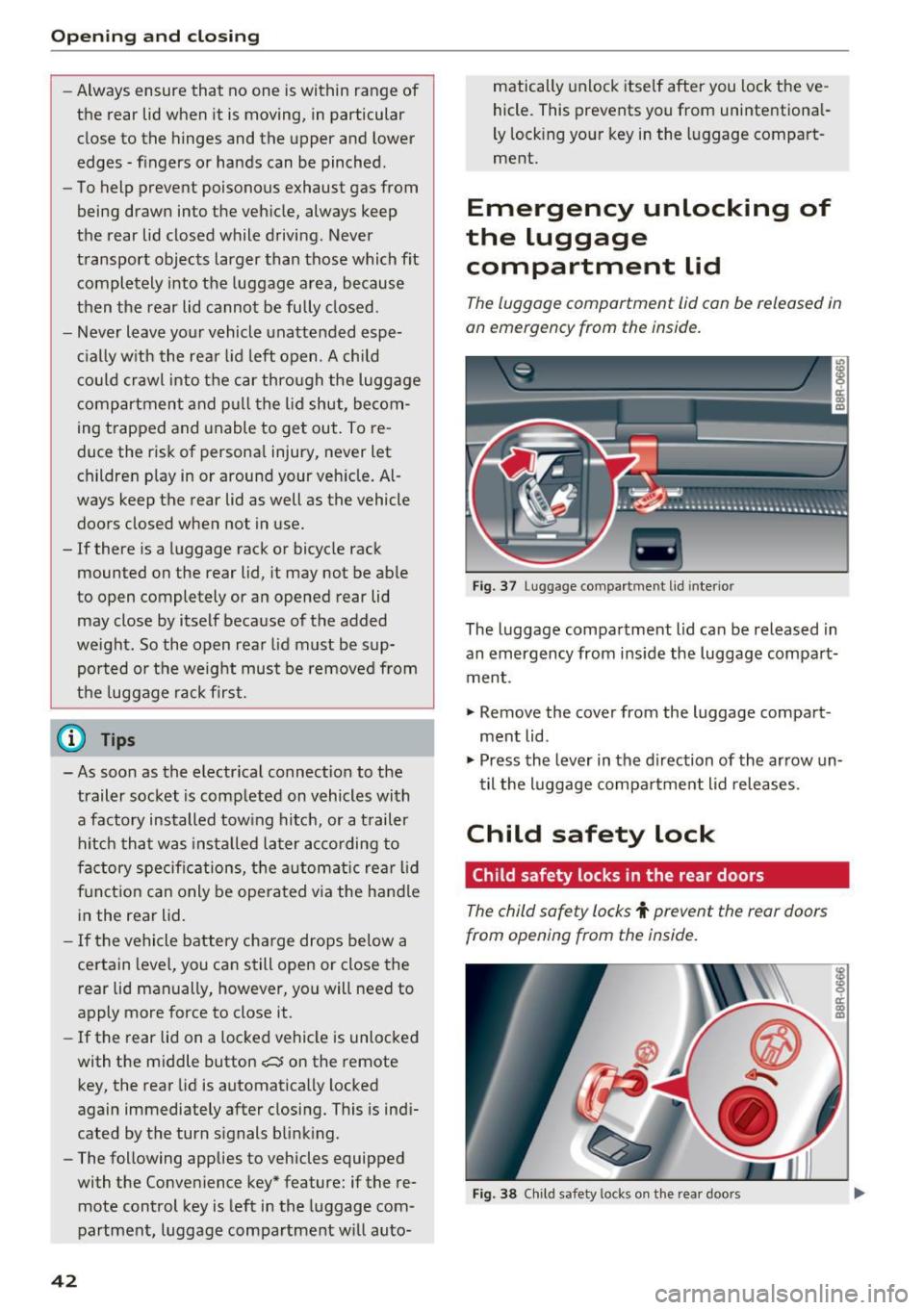
Opening and closing
-Always ensure that no one is within range of
the rear lid when it is moving, in particular
close to the hinges and the upper and lower
edges -fingers or hands can be pinched.
- To help prevent poisonous exhaust gas from
being drawn into the vehicle, always keep
the rear lid closed while driving. Never
transport objects larger than those which fit
completely into the luggage area, because
then the rear lid cannot be fully closed.
- Never leave your vehicle unattended espe
cially with the rear lid left open. A child
could crawl into the car through the luggage
compartment and pull the lid shut, becom
ing trapped and unable to get out. To re
duce the risk of personal injury, never let
children play in or around your vehicle. Al
ways keep the rear lid as well as the vehicle doors closed when not in use.
- If there is a luggage rack or bicycle rack
mounted on the rear lid, it may not be able
to open completely or an opened rear lid may close by itself because of the added
weight. So the open rear lid must be sup
ported or the weight must be removed from
the luggage rack first.
(D Tips
-As soon as the electrical connection to the
trailer socket is completed on vehicles with
a factory installed towing hitch, or a trailer
hitch that was installed later according to
factory specifications, the automatic rear lid
funct ion can only be operated via the handle
in the rear lid.
- If the vehicle battery charge drops below a
certain level, you can still open or close the
rear lid manually, however, you will need to
apply more force to close it.
- If the rear lid on a locked vehicle is unlocked
with the middle button
.::::::5 on the remote
key, the rear lid is automatically locked
again immediately after closing. This is indi
cated by the turn signals blinking.
- The following applies to vehicles equipped
with the Convenience key* feature: if the re
mote control key is left in the luggage com
partment, luggage compartment will auto-
42 matically unlock
itself after you lock the ve
hicle. This prevents you from unintentional
ly locking your key in the luggage compart
ment.
Emergency unlocking of
the luggage compartment lid
The luggage comportment lid con be released in
on emergency from the inside.
Fig . 37 Lugg age compartment lid interio r
The luggage compartment lid can be released in
an emergency from inside the luggage compart
ment .
"" Remove the cover from the luggage compart
ment lid.
""Press the lever in the direction of the arrow un
til the luggage compartment lid releases.
Child safety lock
Child safety locks in the rear doors
The child safety locks t prevent the rear doors
from opening from the inside.
Fig. 38 Child safety locks on the rear doors
Page 70 of 296
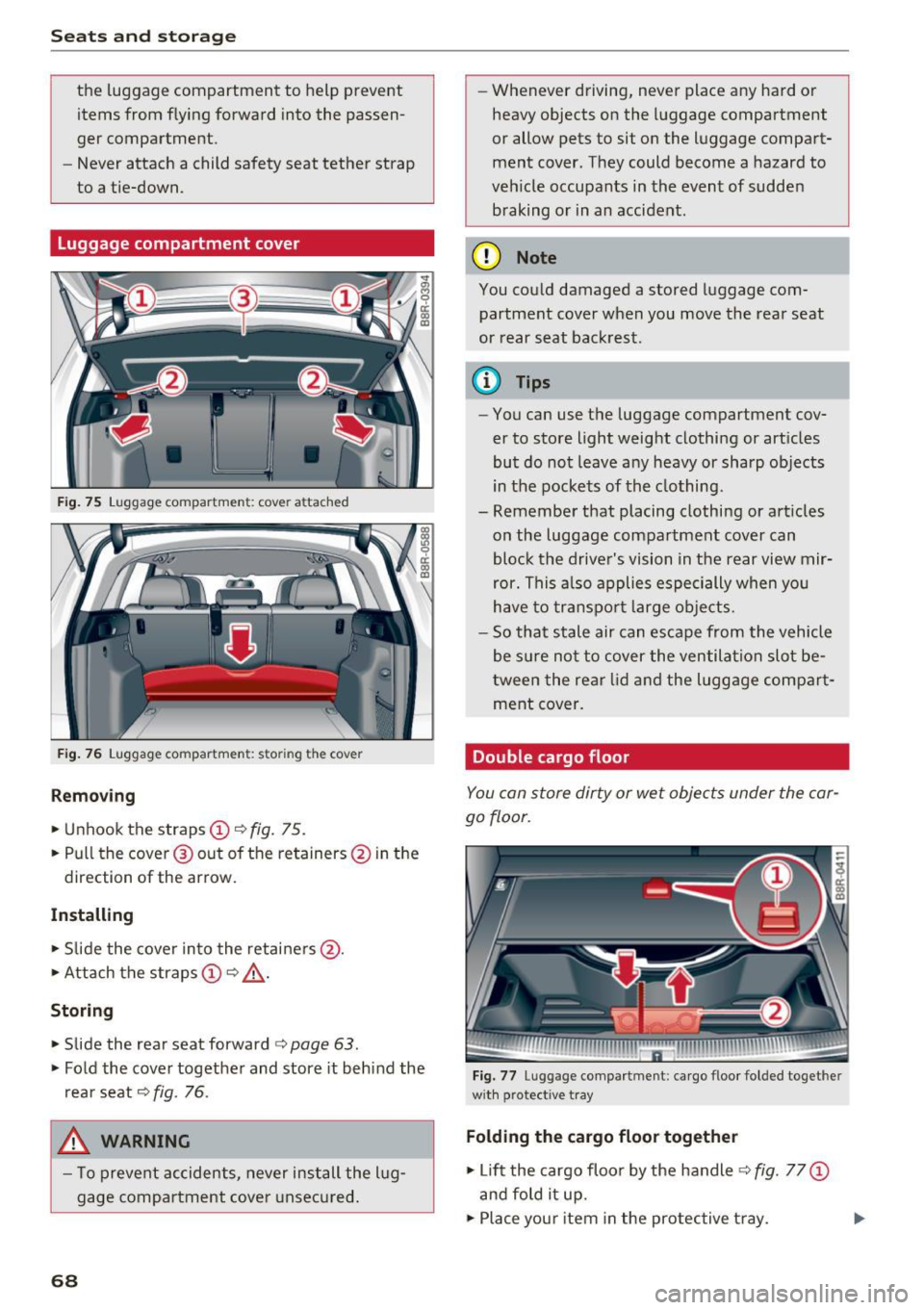
Seats and storage
the luggage compartment to help prevent
items from flying forward into the passen
ger compartment.
- Never attach a child safety seat tether strap
to a tie-down.
Luggage compartment cover
Fig. 75 Luggage compartment: cover attached
Fig. 76 Luggage compartment: storing the cover
Removing
• Unhook the straps@ c::> fig. 75.
• Pull the cover @out of the retainers @ in the
direction of the arrow.
Installing
• Slide the cover into the retainers @.
• Attach the straps
(D c::> & .
Storing
• Slide the rear seat forward <=> page 63.
• Fold the cover together and store it behind the
rear seat
c::> fig. 76 .
_&. WARNING
-To prevent accidents, never install the lug
gage compartment cover unsecured.
68
-
-Whenever driving, never place any hard or
heavy objects on the luggage compartment
or allow pets to sit on the luggage compart
ment cover. They could become a hazard to
vehicle occupants in the event of sudden braking or in an accident.
(D Note
You could damaged a stored luggage com
partment cover when you move the rear seat
or rear seat backrest.
@ Tips
- You can use the luggage compartment cov
er to store light weight clothing or articles
but do not leave any heavy or sharp objects
in the pockets of the clothing.
- Remember that placing clothing or articles on the luggage compartment cover can
block the driver's vision in the rear view mir
ror. This also applies especially when you
have to transport large objects.
- So that stale air can escape from the vehicle
be sure not to cover the ventilation slot be
tween the rear lid and the luggage compart
ment cover.
Double cargo floor
You can store dirty or wet objects under the car
go floor.
Fig. 77 Luggage compartment: cargo floor folded toget her
wit h protective tray
Folding the cargo floor together
• Lift the cargo floor by the handle c::> fig. 77 (D
and fold it up.
• Place your item in the protective tray.
Page 73 of 296
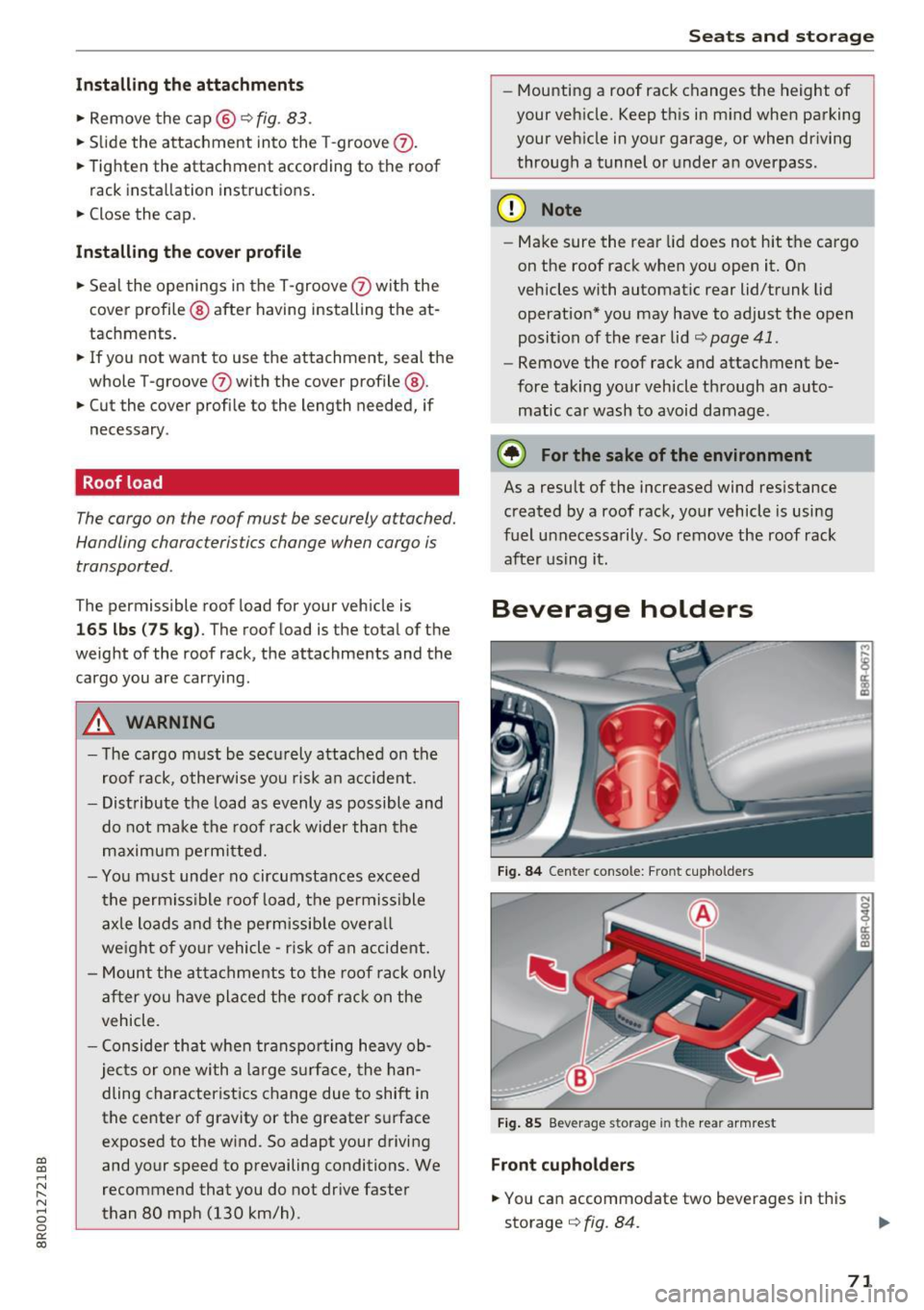
a,
a,
..... r-1 ,-... r-1 ..... 0 0
0:
co
Installing the attachments
• Remove the ca p @ q fig . 83 .
• Slide the attachment into the T-groove 0-
• Tighten the attachment according to the roof
rack installation inst ructions .
• Close the cap.
Install ing the cov er profile
• Seal the openings in the T-groove 0 with the
cover profile @ after hav ing installing the at
tachments.
• If you not want to use th e attachment, seal the
whole T-groove
0 with the cover profile @.
• Cut t he cover profile to the length needed, if
necessary .
Roof load
The cargo on the roof mus t be securely attached.
Handling charac teristics change when cargo is
transported .
The permissible roof load for your veh icle is
165 lbs (75 kg ). The roof load is the total of the
weight of the roof rack, the attachme nts and the
cargo you are carrying .
_&, WARNING
- The cargo m ust be sec urely attached on the
roof rack, otherwise yo u risk a n accide nt.
- Dist ribute the load as evenly as possible and
do not make the roof rack wider than the
m ax imum permitted.
- Yo u must unde r no circumstances exceed
t he perm iss ible roof load, the permiss ible
ax le loads and the pe rm issib le overa ll
we ight of yo ur vehicle -risk of an accident.
- M ount the a ttachments to the roof rack only
after you have placed the roof rack on the
vehicle .
- C onsider that whe n transpo rting heavy ob
je cts or one wi th a large s urf ac e, the han
dling characterist ics c hange due to shift in
the cente r of gravity or the greater s urface
exposed to the w ind. So adapt your driving
and your speed to prevailing conditions. We
recommend that you do not dr ive faster
than 80 mp h (130 km/h) .
Seats and storag e
-Mounting a roof rack changes the height of
your veh icle. Keep t his in m ind when parking
your veh icle in your garage, or when dr iving
through a tunnel o r under a n overpass.
(D Note
- Ma ke sure the rea r lid does not hit the cargo
on the roof rack when you open it. On
vehicles with automatic rear lid/trunk lid
operation* you may have to adjust the open
position of the rear lid
~ page 41.
- Remove the roof rack and attachment be
fore taking your vehicle th rough an auto
matic car wash to avoid damage .
@ For the sake of the environment
As a result of the increased wind res istance
created by a roof rack, your vehicle is using
fuel u nnecessarily . So remove the roof rack
aft er using it.
Beverage holders
Fig . 84 Cente r conso le: Fro nt c upho lders
Fig. 85 Beverage storage in th e rea r arm rest
Front cupholders
• You ca n accommo date two beverages in this
storage
q fig . 84 .
71
Page 78 of 296
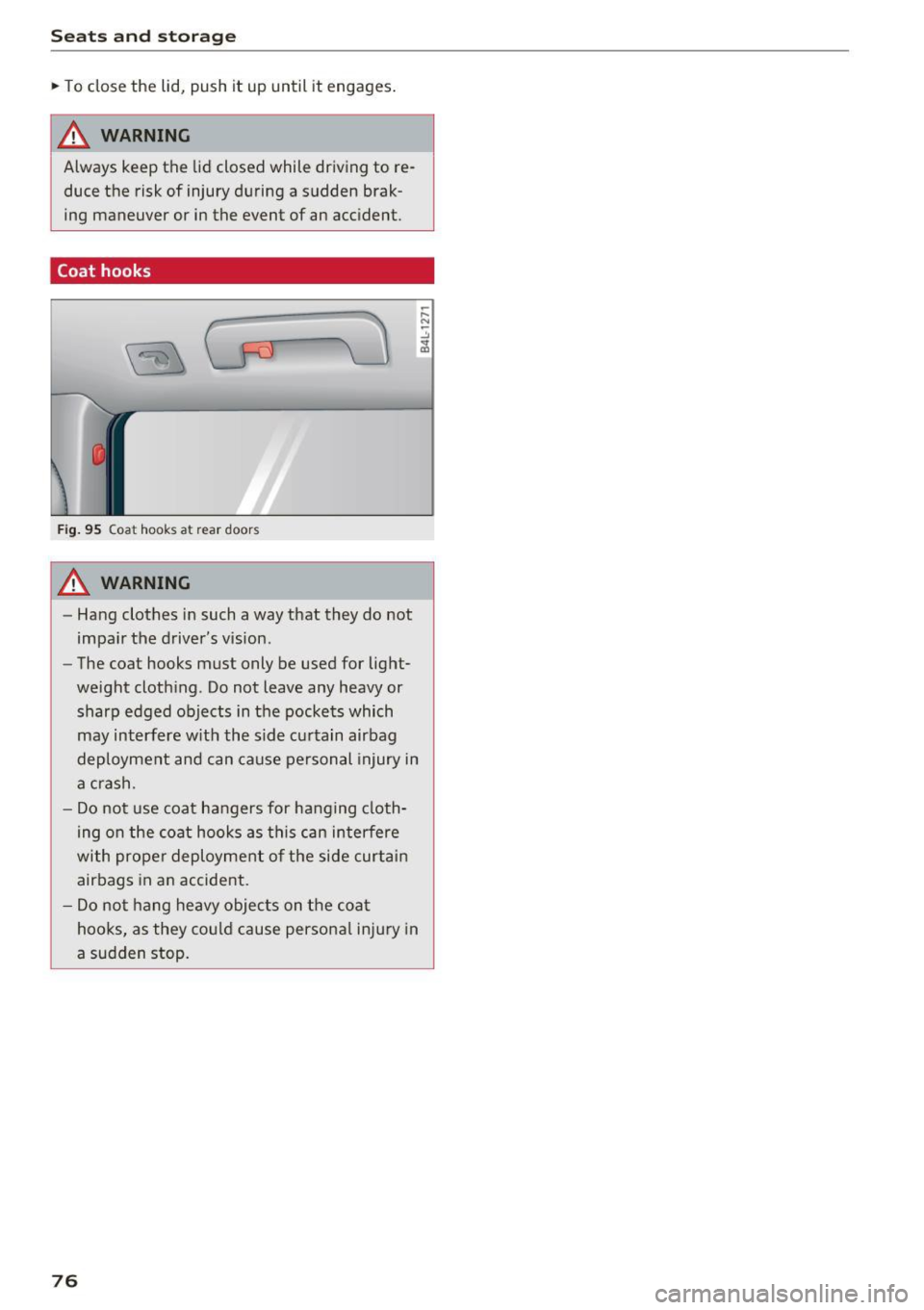
Sea ts and stor age
~ To close the lid, push it up until it engages .
A WARNING
Always keep the lid closed while driving to re
duce the risk of injury during a sudden brak
ing maneuver or in the event of an accident.
Coat hooks
Fig . 95 Coa t hooks a t re ar doors
A WARNING
- Hang clothes in such a way that they do not
impa ir the driver's vision .
- The coat hooks must only be used for light
weight cloth ing . Do not leave any heavy or
sharp edged objects in the pockets which may interfere w it h the side cu rtain airbag
deployment and can cause personal injury in
a crash .
- Do not use coat hangers for hanging cloth
ing on the coat hooks as this can interfere
with prope r deployment of the side curtain
airbags in an accident.
- Do not hang heavy objects on the coat
hooks, as they could cause personal injury in
a sudden stop.
7 6
Page 90 of 296
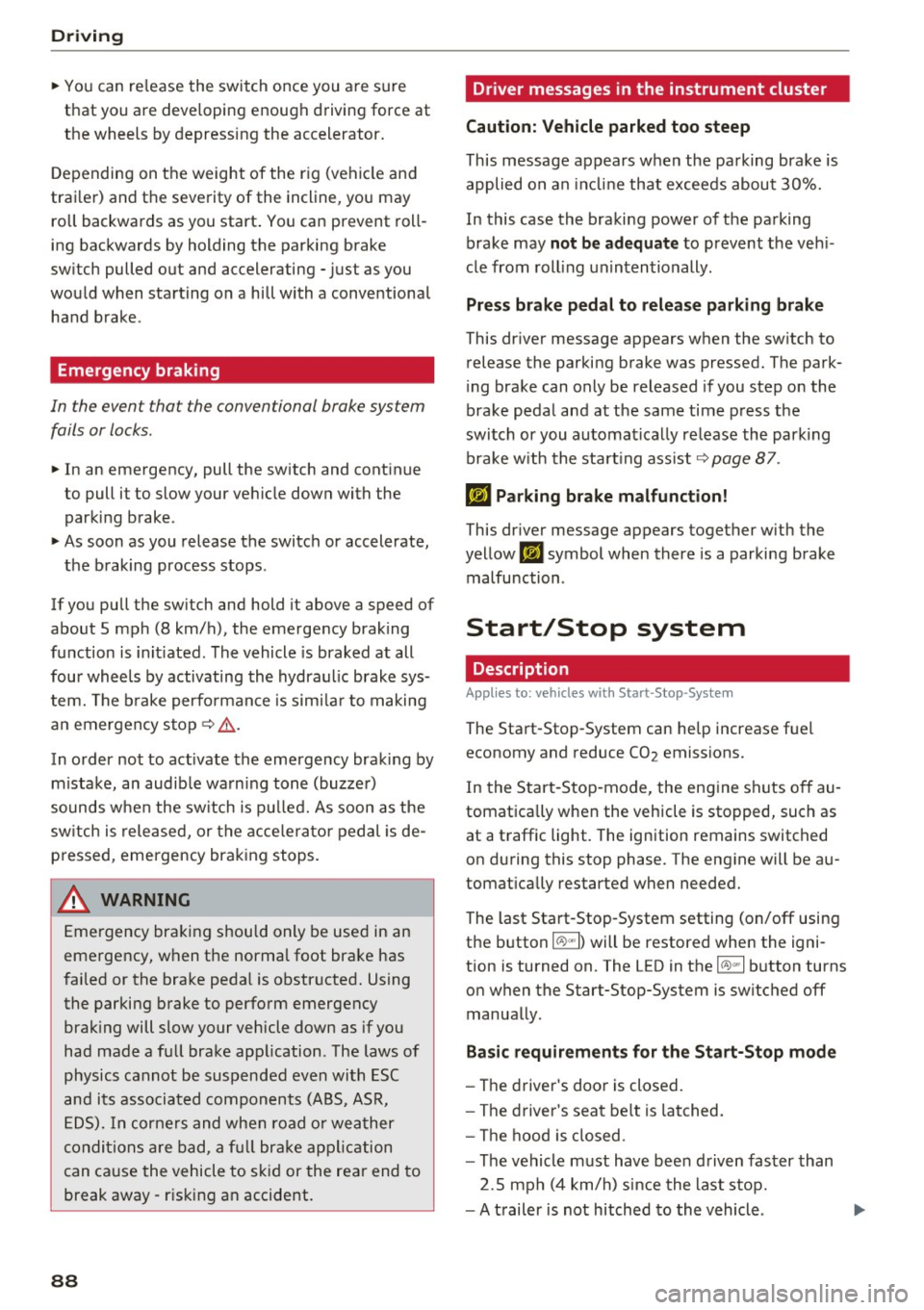
Driving
"'You can re lease the switch once you are sure
that you are developing enough driving force at
the wheels by depressing the accelerator.
Depending on the weight of the r ig (vehi cle and
trai ler) and t he severity of the incline, you may
ro ll backwards as you start . You ca n prevent roll
ing bac kwards by holding the parking brake
sw itch pulled out and accelerating -just as you
wou ld when sta rting on a hill with a conventional
hand b rake.
Emergency braking
In the even t that the conventional brake system
fails or locks .
"'In an emergency, pull the switch and cont inue
to pull it to slow your ve hicle down with the
park ing b rake .
"' As soon as you release the switch or accelerate,
the b raking process stops .
If you pull the sw itch and hold it above a speed of
about 5 mph (8 km/h), the eme rge ncy brak ing
f u nction is ini tiated . The vehicle is braked at all
four whee ls by activating th e hydrau lic brake sys
t em. T he b rake perfo rman ce is sim ila r to making
a n emergency stop ~.&, .
In order not to activate the emergency brak ing by
mista ke, an audib le wa rn ing tone (buzz er)
sounds w hen the sw itch is p ulled . As soon as the
sw itch is rele ased, or the a cce le ra to r pedal is de
p ressed, eme rgency bra king stops.
_& WARNING
Emergency braking should only be use d in an
emergency, w hen the normal foot brake has
failed or the bra ke peda l is obstr ucted . Using
the parking b rake to perfo rm emergency
brak ing will slow your vehicle down as if you
had made a fu ll bra ke ap plication . The laws of
physics c annot be suspended even wi th E SC
a nd i ts asso ciated componen ts (AB S, AS R,
ED S). I n corne rs and when r oad or we ather
c ondi tions are bad , a f ull bra ke ap plicat ion
can ca use the vehicle to sk id or the rea r end to
break away -ris king an accident .
88 '
Driver messages in the instrument cluster
Caution: Vehicle parked too steep
This message appears when the pa rking brake is
applied on an in cl in e that exceeds about 30%.
In this case the braking power of the pa rking
brake may
not be adequate to prevent the veh i
cle from roll ing unin ten tionally.
Press b rake pedal to release parking brake
This dr iver message appears when the sw itch to
r elease the parking brake was pressed. The pa rk
i ng brake can only be released if you step on the
brake pedal and at the same time p ress the
switch or you automat ica lly re lease the par king
bra ke w ith the sta rting ass is t ~
page 87 .
f pj Parking brake malfunction!
This dr iver message appears together with the
yellow
DI symbol when there is a parki ng b rake
malfunction .
Start/Stop system
Description
Applies to: vehicles wit h Start ·Stop ·System
The Sta rt -Stop-System can he lp increase f uel
economy and reduce CO2 emissions.
I n the Start -Stop -mode, the eng ine sh uts off au
tomat ica lly when the vehicle is sto pped, such as
at a t raff ic light. The ignition remains switched
on du ring this stop phase . The eng ine will be au
tomat ically restarted when needed.
The last Start-Stop -System setting (on/off using
the b utton
l(A)~ I) will be restored when the igni
tion is turned on. The L ED in t he
l(A) ~I b utton turns
o n when the Start-Stop-System is switched off
manua lly .
Ba sic requirements for the Start-Stop mode
- The driver 's door is closed.
- The drive r's sea t b elt is latched.
- The hood is closed .
- The vehicle m ust have bee n driven fas ter than
2.5 mph (4 km/h) s ince the last s top.
- A t railer is not hitched to the vehicle . .,.
Page 139 of 296
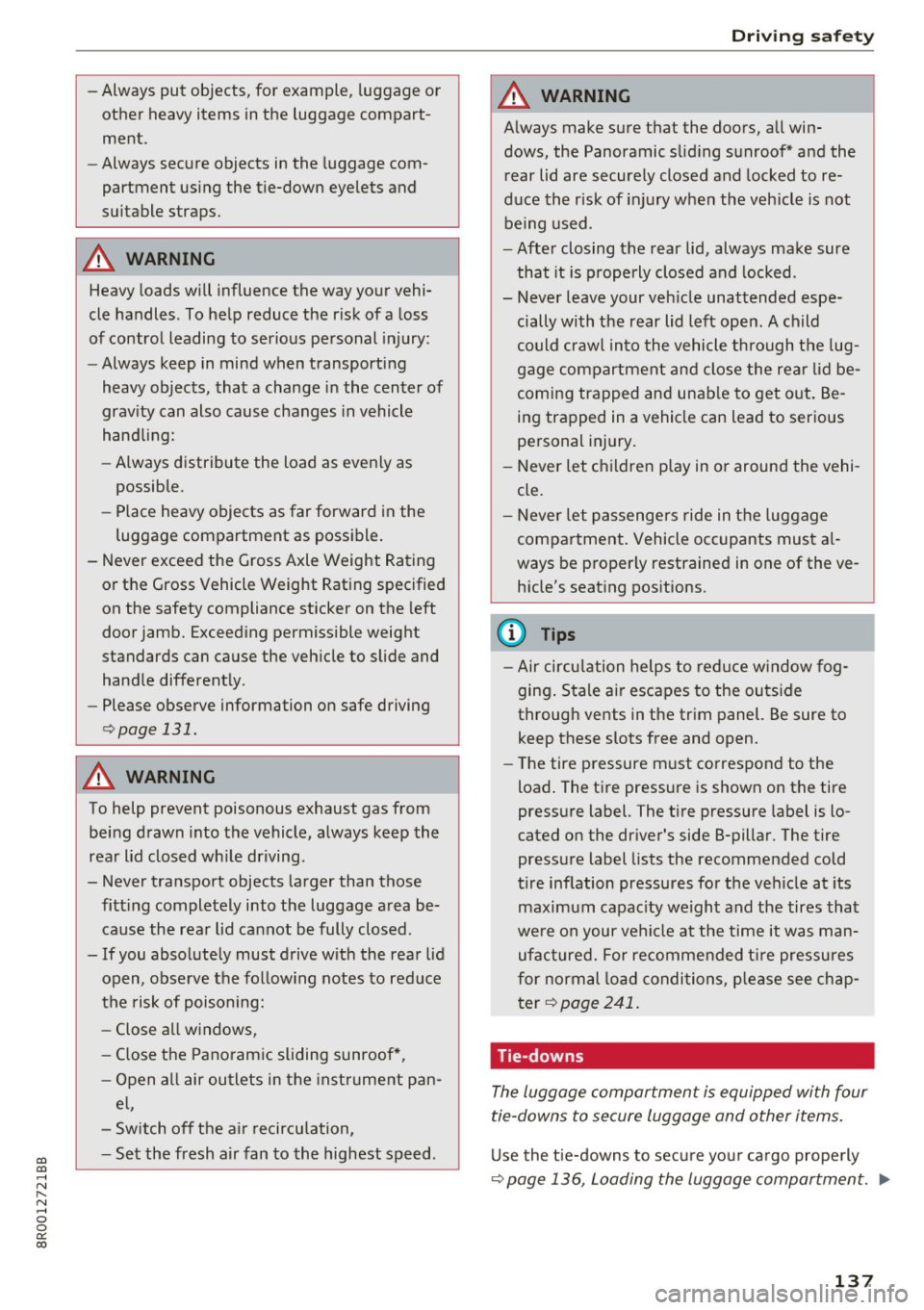
CD
CD
.... N ,-... N .... 0 0 C<'. 00
-Always put objects, for example, luggage or
other heavy items in the luggage compart
ment.
- Always secure objects in the luggage com
partment using the tie-down eyelets and
suitable straps.
A WARNING
Heavy loads will influence the way your vehi
cle handles . To help reduce the risk of a loss
of control leading to serious personal injury:
- Always keep in mind when transporting
heavy objects, that a change in the center of
gravity can also cause changes in vehicle
hand ling:
- Always distribute the load as evenly as
possible.
- Place heavy objects as far forward in the
luggage compartment as possible.
- Never exceed the Gross Axle Weight Rating
or the Gross Vehicle Weight Rating specified
on the safety compliance sticker on the left
door jamb. Exceeding permissible weight
standards can cause the vehicle to slide and
handle differently .
- Please observe information on safe driving
<=>page 131.
A WARNING
To help prevent poisonous exhaust gas from
being drawn into the vehicle, always keep the
rear lid closed while driving .
- Never transport objects larger than those
fitting completely into the luggage area be
cause the rear lid cannot be fully closed .
- If you absolutely must drive with the rear lid
open, observe the following notes to reduce
the risk of poisoning:
- Close all windows,
- Close the Pano ramic sliding sunroof*,
- Open all air outlets in the instrument pan-
el,
- Switch off the air recirculation,
- Set the fresh air fan to the highest speed .
Driving safety
A WARNING
-
Always make sure that the doors, all win
dows, the Panoramic sliding sunroof* and the
rear lid are securely closed and locked to re
duce the risk of injury when the vehicle is not
being used .
-After closing the rear lid, always make sure
that it is properly closed and locked.
- Never leave your vehicle unattended espe
cially with the rear lid left open. A child
could crawl into the vehicle through the lug
gage compartment and close the rear lid be
coming trapped and unable to get out. Be
ing trapped in a vehicle can lead to serious
personal injury.
- Never let children play in or around the vehi
cle.
- Never let passengers ride in the luggage
compartment. Vehicle occupants must al
ways be properly restrained in one of the ve
hicle's seating positions.
(D Tips
-Air circulation helps to reduce w indow fog
ging . Stale air escapes to the outside
through vents in the trim panel. Be sure to
keep these slots free and open.
- The tire pressure must correspond to the
load. The tire pressure is shown on the tire
pressure label. The tire pressure label is lo
cated on the driver's side B-pillar . The tire
pressure label lists the recommended cold
tire inflation pressures for the vehicle at its
maximum capac ity weight and the tires that
were on your vehicle at the time it was man
ufactured. For recommended t ire pressures
for normal load conditions, please see chap
ter
r=> page 241.
Tie-downs
The luggage compartment is equipped with four
tie-downs to secure luggage and other items.
Use the tie-downs to secure your cargo properly
Q page 136, Loading the luggage compartment . ..,_
137
Page 140 of 296
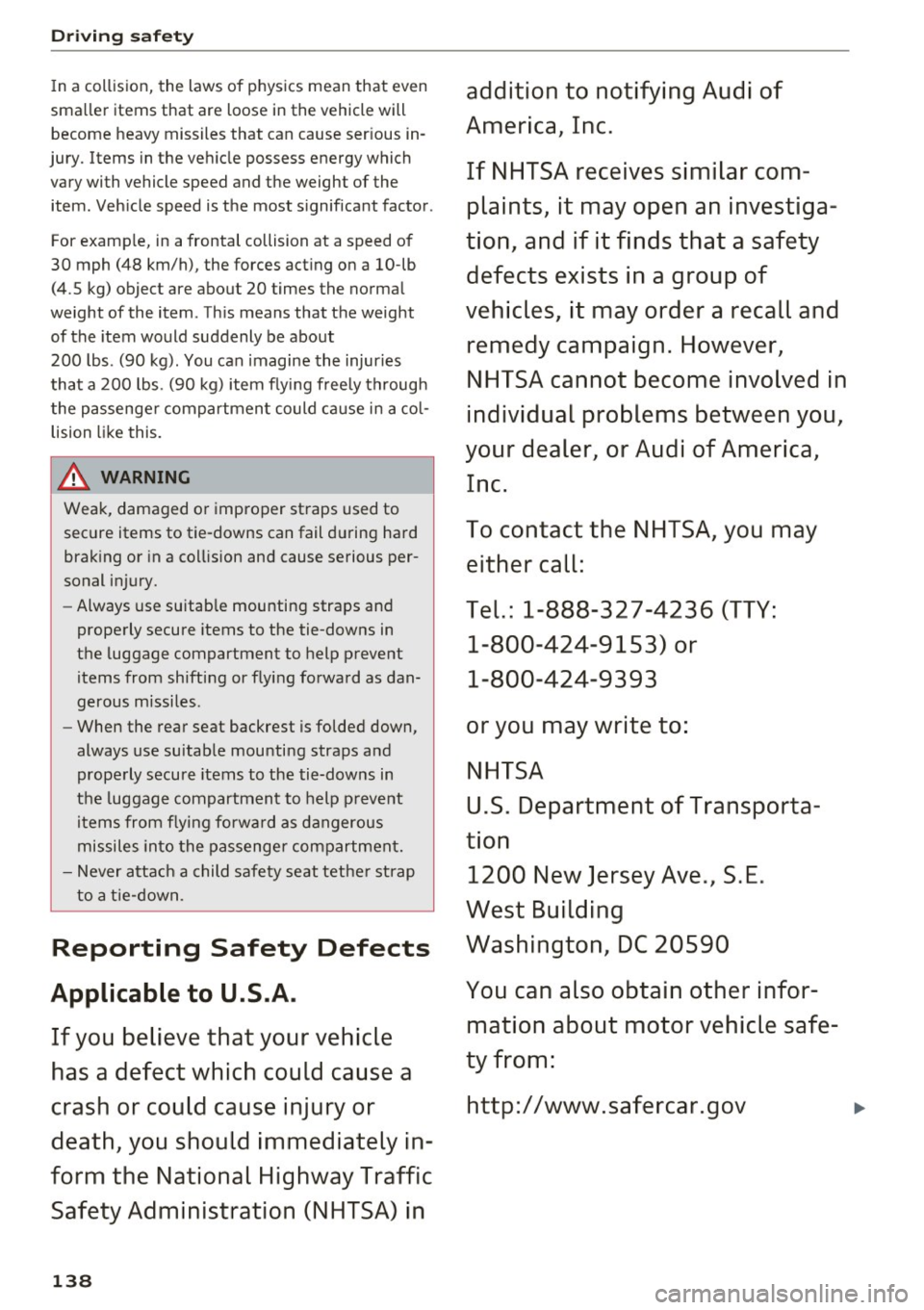
Driving sa fe ty
In a collision, the laws of physics mean that even
sma ller items that are loose in the vehicle will
become heavy missiles that can cause ser ious in
jury. Items in the veh icle possess energy which
vary with vehicle speed and the weight of the
item . Veh icle speed is the most s ignificant factor .
For examp le, in a frontal collision at a speed of
30 mph (48 km/h), the forces act ing on a 10-lb
(4.5 kg) object are about 20 times the normal
weight of the item . Th is means that the weight
of the item would suddenly be about
200 lbs . (90 kg) . You can imagine the injuries
that a 200 lbs. (90 kg) item flying free ly through
the passenge r compartmen t could c ause in a co l
lision like this.
A WARNING
Weak, damaged or improper straps used to
secure items to tie-downs can fail d uring hard
brak ing or in a collision and cause serious per
sonal injury.
- Always use suitab le mounting straps and
properly secure items to the tie-downs in
the luggage compartment to help p revent
items from shifting or flying forward as dan
gerous missiles.
- When the rear seat backrest is folded down,
always use suitab le mounting straps and
properly secure items to the tie-downs in
the luggage compartment to help p revent
items from flying forwa rd as dangerous
missiles into the passenger compartment.
- Never a ttach a child safety seat tethe r strap
to a tie-down.
Reporting Safety Defects
Applicable to U.S.A.
If yo u b eliev e that your vehi cle
h as a defect which could cause a
c ra sh or could cau se injur y or
d ea th, you should immedi ately in
form th e National Highw ay Tr affi c
Safet y Admini str ation (NHTSA ) in
138
ad dition t o notif yin g Audi of
Amer ic a, Inc .
If NHTSA re ce iv es similar com
pl aint s, it ma y op en an in vestiga
tion , and if it finds that a safety
defect s ex ists in a group of
vehicles, it m ay order a recall and
remedy campaign. Howe ver,
NHTS A cann ot b ecome in volved in
indi vidual probl em s bet ween you,
your dealer, or Audi of America,
Inc.
To conta ct th e NHT SA, you ma y
e ither call:
T el.: 1-888- 327-4236 (TT Y:
1-800-4 24-9 153) o r
1-800-424-9393
or you ma y write t o:
NHTSA
U .S. Dep art ment of Tran sp o rta
tion 1200 Ne w Jers ey Ave ., S. E.
W est Building
W ashington , DC 20590
You can also obtain other info r
mation about motor vehicle safe
ty from:
http: / /www. safer car.go v
Page 143 of 296
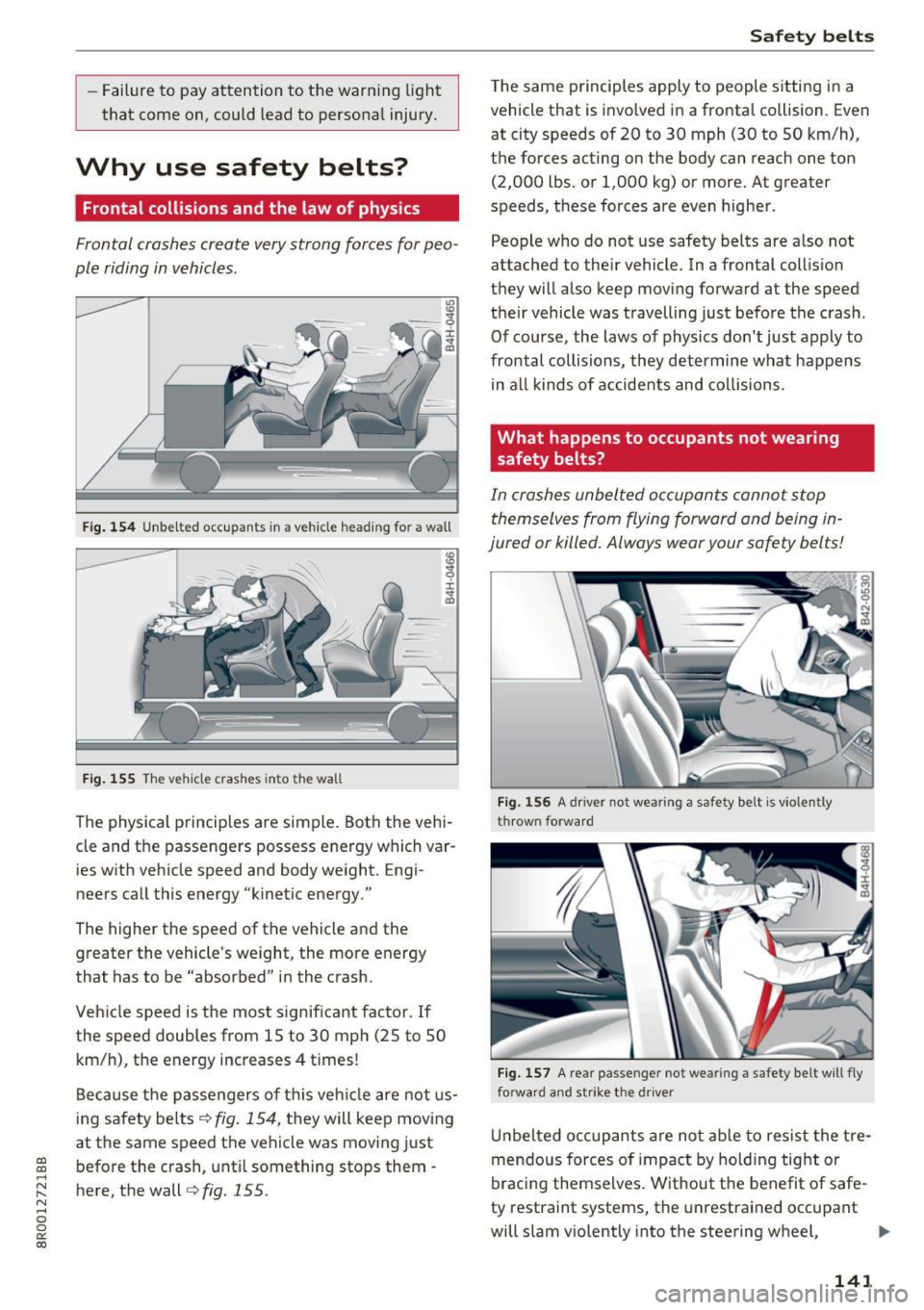
a,
a,
..... N r-N ..... 0 0
0:
co
-Failure to pay attention to the warn ing light
that come on, could lead to persona l injury.
Why use safety belts?
Frontal collisions and the law of physics
Frontal crashes create very strong forces for peo
ple riding in vehicles .
Fig. 154 Unbelted occupants in a vehicle heading for a wall
Fig. 155 The vehicle crashes into the wall
The physical principles are simple. Both the vehi
cle and the passengers possess energy which var ies with vehicle speed and body weight. Engi
neers call this energy "kinetic energy."
The higher the speed of the vehicle and the greater the vehicle's we ight, the more energy
that has to be "absorbed" in the crash.
Veh icle speed is the most significant factor. If
the speed doubles from 15 to 30 mph (25 to 50
km/h), the energy increases 4 t imes!
Because the passengers of this vehicle are not us
ing safety belts
¢fig. 154, they will keep moving
at the same speed the vehicle was moving just
before the crash, until something stops them -
here, the wall¢
fig. 155 .
Safety belts
The same p rinciples apply to people sitting in a
vehicle that is invo lved in a fronta l co llision. Even
at city speeds of 20 to 30 mph (30 to 50 km/h),
the forces acting on the body can reach one ton
(2,000 lbs. or 1,000 kg) or more. At greater
speeds, these forces are even higher.
People who do not use safety belts are a lso not
attached to the ir vehicle. In a frontal collis ion
they will also keep moving forward at the speed
their vehicle was travelling just before the crash .
Of course, the laws of physics don't just apply to
frontal collisions, they determine what happens in all kinds of accidents and collisions .
What happens to occupants not wea ring
safety belts?
In crashes unbelted occupants cannot stop
themselves from flying forward and being in
jured or killed. Always wear your safety belts!
Fig. 156 A dr iver not wearing a safety belt is violently
thrown forward
Fig . 157 A rear passe nger not wearing a safety belt will fly
forwa rd and strike the driver
Unbelted occupants are not able to resist the tre
mendous forces of impact by holding tight or
bracing themselves . Without the benefit of safe
ty restraint systems, the unrestrained occupant
will slam v iolently into the steering wheel,
Ill>-
141
Page 152 of 296
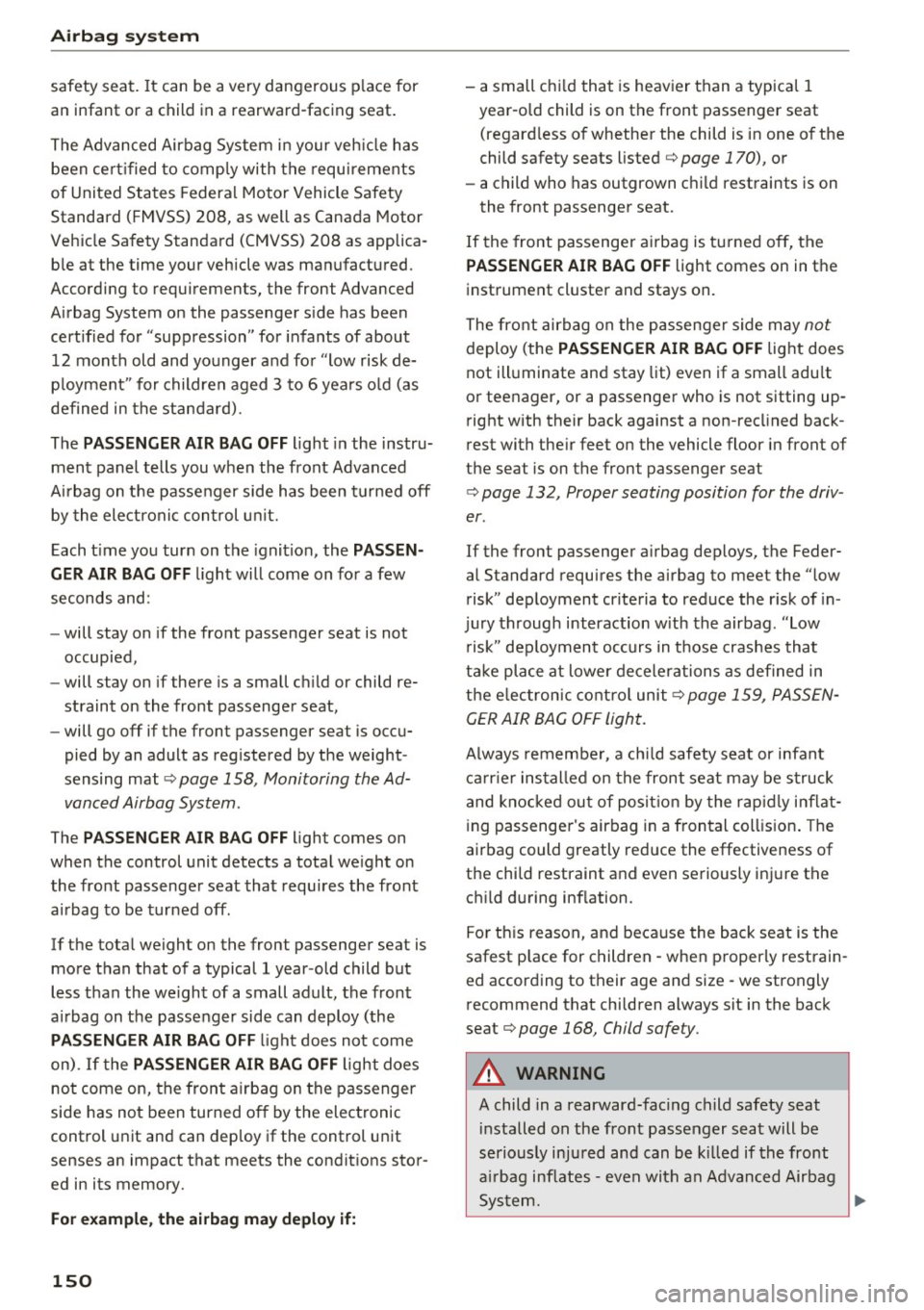
Airbag syste m
safety seat. It can be a very dangerous p lace for
an infant or a child in a rearward-facing seat.
The Advanced Airbag System i n your veh icle has
been ce rt ified to comp ly with the requirements
of United States Federal Motor Vehicle Safety
Standard (FMVSS)
208, as well as Canada Motor
Veh icle Safety Standard (CMVSS)
208 as applica
b le at the time your vehicle was manufactured.
According to requirements, the front Advanced
Airbag System on the passenger s ide has been
certified for "suppression " for infants of about
12 month old and younger and for "low risk de
p loyment " for children aged
3 to 6 years o ld (as
defined in the standard).
The
PA SSENGER AIR BAG OFF light in the instru
ment panel tells you when the front Advanced
Ai rbag on the passenger side has been tu rned off
by the elect ronic cont rol unit.
Each t ime you tur n on the ignit ion , the
PASSEN
GER AIR BAG OFF
light will come on fo r a few
seconds and :
- will stay on if the front passenger seat is not
occupied,
- will s tay on if there is a small c hild or child re
straint on the front passenger seat,
- will go off if the front passenger seat is occu
pied by an adult as reg istered by the weight
sensing mat¢
page 158, Monitoring the Ad
vanced Airbag System .
The PAS SENGER AIR BAG O FF light comes on
when the control unit detects a total we ight on
the front passenger seat that requires the front
airbag to be turned off.
If the tota l weight on the front passenger seat is
more than that of a typical 1 year -old child but
less than the we ight of a small adult, the front
a irbag on the passenger side can deploy (the
PAS SENGER AIR BAG OFF light does not come
on) .
If the PAS SENGER AIR BAG OFF light does
not come on, the front a irbag on the passenger
side has not been turned off by the electronic
control unit and can deploy if the control unit
senses an impact that meets the condit ions stor
ed in its memory.
For e xample, the airbag may deploy if:
150
- a small chi ld that is heavier than a typica l 1
year-o ld child is on th e front passenger seat
(regard less of whether the child is in one of the
child safety seats listed¢
page 170), or
- a child who has outgrown c hild restraints is on
the front passenger seat.
If the front passenger a irbag is t urned off, the
PASSENGER AIR BAG OFF light comes on in the
instrument cluster and stays on.
The fro nt airbag on the passenge r side may
not
deploy (the PAS SENGER AIR BAG OFF light does
not ill uminate and stay lit) even if a small adu lt
or teenager, or a passenger who is not sitting up
right with thei r back against a non-recl ined back
rest with the ir fee t on the vehicle floor in front of
the sea t is on the fron t passenger sea t
<=> page 132, Proper seating position for the driv
er .
If the front passenger a irbag deploys, the Feder
al Standard requires the airbag to meet the "low
risk" deployment cr iteria to reduce the r isk of in
jury through interaction w ith the airbag . "low
risk " deployment occurs in those crashes that
take place at lowe r de cele rations as defined in
the e lec tronic co ntro l unit ¢
page 159, PASSEN
GER AIR BAG OF F light.
Always remembe r, a chi ld safety seat or infant
c ar rie r ins talled on the front seat may be s truck
and knocked ou t of posit ion by t he rap idly i nflat
i ng passenge r's airbag in a frontal coll is ion . The
airbag could greatly red uce the effectiveness of
the child restraint and even seriously injure the child during inflation.
Fo r th is reason, and beca use the back seat is the
safest place for children -when properly restrain
ed according to their age and size -we strongly
recommend that children always sit in the back
seat
c> page 168, Child safety .
A WARNING
A child in a rearward-facing child safety seat
installed on the front passenger seat will be
seriously injured and can be killed if the front
a ir bag inflates - even with an Advanced Airbag
Sys tem.
Ill>
Page 153 of 296
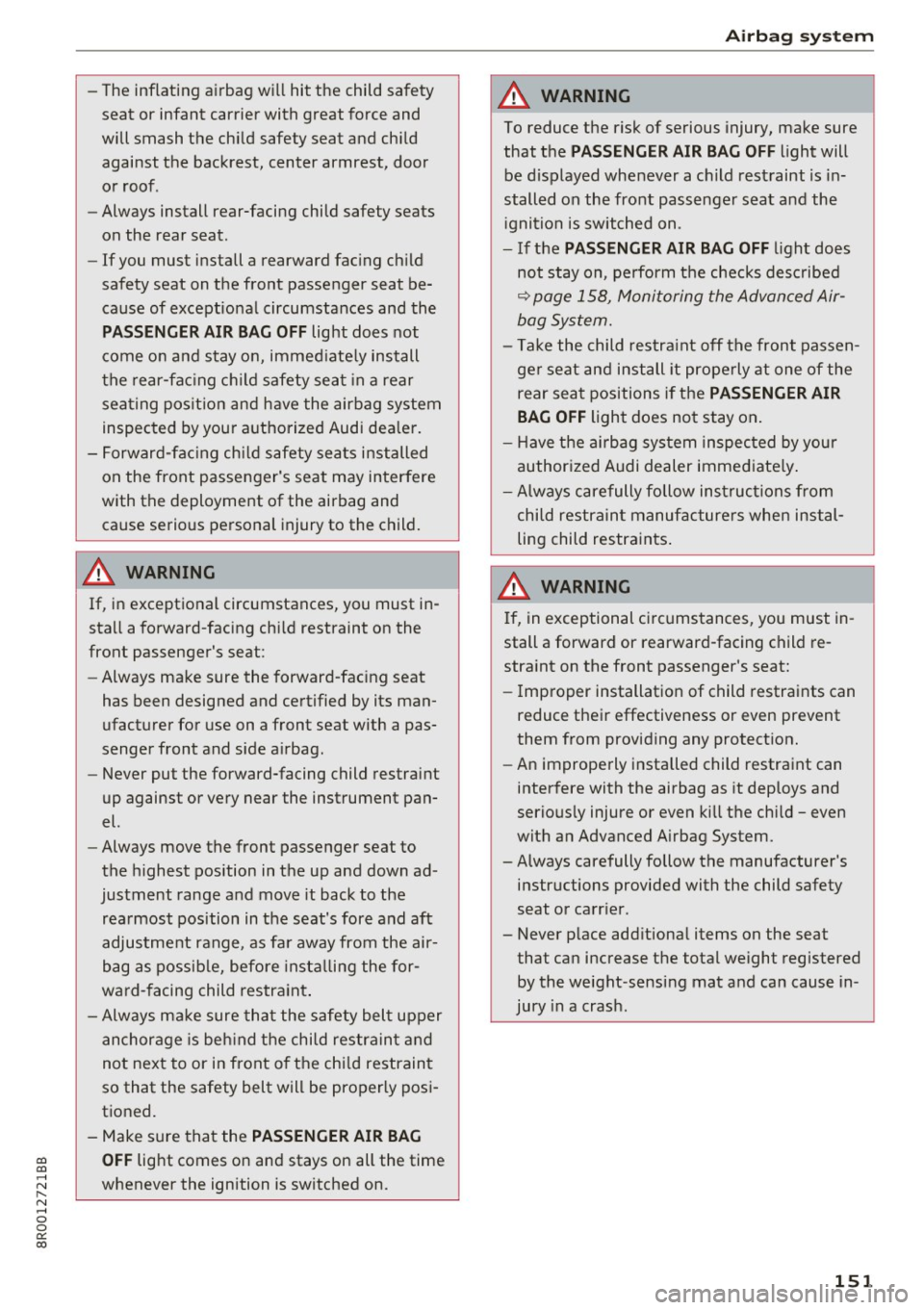
CD
CD
.... N ,-... N ..... 0 0 C<'. 00
-The inflating airbag will hit the child safety
seat or infant carrier with great force and
will smash the chi ld safety seat and child
against the backrest, center armrest, door
or roof .
- Always install rear-facing child safety seats
on the rear seat.
- If you must install a rearward fac ing ch ild
safety seat on the front passenger seat be cause of exceptional circumstances and the
PASSENGER AIR BAG OFF light does not
come on and stay on, immed iate ly install
the rear-fac ing ch ild safety seat in a rear
seating pos it ion and have the airbag system
inspected by your a uthorized Audi dea le r.
- Forward-fac ing ch ild safety sea ts installed
on the front passenger's seat may interfere
with the deployment of the airbag and
cause serious personal injury to the child.
~ WARNING
If, in except ional circumstances, you must in
stall a forward-facing chi ld restraint on the
front passenger 's seat:
- Always ma ke sure the forward-fac ing seat
has been designed and certified by its man
ufacturer for use on a front seat with a pas
senger front and s ide a irbag.
- Never put the forward-facing child restraint
up against or very near the instrument pan
el.
-Always move the front passenger seat to
the highest position in the up and down ad
justment range and move it back to the
rea rmost position in the seat's fore and aft
adjustment range, as fa r away from the air
bag as possib le, before insta lling the for
ward- facing child restra int .
- Always ma ke sure tha t the safety belt upper
anchorage is beh ind the child restrain t and
not next to or in front o f the chi ld restraint
so that the safety belt will be properly pos i
tioned.
- Make sure that the
PASSENGER AIR BAG
OFF
light comes on and stays on all the time
whenever the ignition is switched on.
Airb ag sys tem
A WARNING
To reduce the risk of serious injury, make sure
that the
PASSENGER AIR BAG OFF light will
be d isplayed whenever a child restraint is in
stalled on the front passenger seat and the
i gnition is switched on .
-If the PASSENGER AIR BAG OFF light does
not stay on , perform t he checks desc ribed
~ page 158, Monitoring the Advanced Air
bag System.
- Take the child restra int off t he front passen
ge r seat an d install it prope rly at one of the
rear sea t positions i f the
PASSENGER AIR
BAG OFF
light does not stay on .
- Have the air bag system inspec ted by your
author ized Audi dealer immed iate ly .
- Always c are fully follow ins tructions from
child restrain t manufacture rs when instal
ling child restraints .
If, in exceptional c ircumstances, you must in
stall a forward or rearward-facing child re
stra int on the front passenger's seat:
- Imp roper installation of child restraints can
reduce their effectiveness or even prevent
them from providing any protect ion.
- An improperly installed child restra int can
interfere with the airbag as it deploys and
serious ly injure or even kill the chi ld -even
with an Advanced A irbag System.
- Always care fully follow the manufacturer 's
instr uctions provided with the child safety
seat or carr ie r.
- Never p lace add itiona l items on the seat
that can increase the total weight registered by the weight -sensing mat and can cause in
jury in a crash.
151